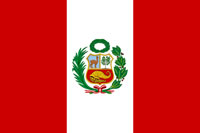|
|||||||||||||
| Report on Peru | |||||||||||||

Republic of PeruPeru is located in Western South America, and extends for nearly 2500 kilometres along the Pacific Ocean. Peru borders Ecuador, Colombia, Brazil, Bolivia and Chile. Geography (click to open)
Peru is officially known as the Republic of Peru. The capital city is Lima, which is also the largest city in the nation. Peru is divided by the Andes Mountains into three sharply differentiated zones - a narrow strip of desert along the coast, a region of high mountains in the center, and a large area of forested mountains and lowlands in the east. Desert Region The desert region stretches the entire length (1,410 miles / 2,269 km) of Peru's Pacific coastline and owes its aridity to the cold Humboldt, or Peru, Current, which acts as a barrier to the moist air over the Pacific. Within the desert are about 40 oases where most of Peru's commercial farming takes place; the principal oases are near Lima, Chiclayo, and Trujillo. Callao (near Lima) and Matarani, Peru's leading ports, are also in the desert region. Central Region The central region (c.200 miles / 320 km wide) is made up mostly of Peoplethree ranges of the Andes Mountains, the Cordillera Occidental in the West and the Cordillera Central and its continuation, the Cordillera Real, in the East. The Cordillera Occidental includes the loftiest peaks, notably Huascarán (22,205 ft/6,768 m, Peru's highest point) and El Misti (19,150 ft/5,837 m). The rugged eastern ranges receive considerable rainfall and are drained by numerous rivers, which have cut deep canyons. Subsistence agriculture is practiced in the upper parts of the valleys. Between the eastern and western ranges of the Andes in the south, and extending into Bolivia, is the Altiplano Plateau, which includes small, scattered basins of arable land and pastureland and also part of Lake Titicaca. The central region includes about 60% of Peru's population; its main cities are Arequipa, Huancayo, Ayacucho, and Cuzco, an old Inca center. Eastern Region The Eastern region includes more than half of the country's land area. It is made up of the highly forested Cordillera Oriental of the Andes and low-lying tropical plains, covered by rain forests and drained by the Amazon River and its tributaries. Population and Society (click to open)
Peru's population is approaching 30 million people as of 2007. About 45% of Peru's population is indigenous, while mestizos make up about 37% and whites 15%. There are also small numbers of persons of Japanese, Chinese, and African descent. Most of the native inhabitants speak Quechua (an official language) or Aymara; they live in the Andes and have retained much of their traditional way of life. Small groups of indigenous peoples live in the isolated rain forest of E Peru and speak a variety of languages. Most other Peruvians speak Spanish (the other official language) and are Roman Catholic. Power and wealth in the country have traditionally been monopolized by the European-descended inhabitants and by a small number of the mestizos; the bulk of the mestizos and virtually all of the indigenous people are labourers or subsistence farmers. The leading universities are at Lima, Arequipa, Trujillo, and Cuzco. Economic Overview (click to open)
Peru is a member of the Andean Community, an economic organization of South American countries. Peru has a large mining industry, the most valuable minerals being copper, silver, gold, iron ore, coal, and phosphate rock. Petroleum and natural gas is produced along the northern coast and in the Amazon basin, and there is a large refinery at Talara. While services and industry are growing segments of the economy, farming is still the predominant economy of Peru. The main farm commodities produced are asparagus, cotton, coffee, sugarcane, rice, potatoes, corn, plantains, grapes, and oranges. Large numbers of poultry, cattle, sheep, llamas, and alpacas are raised in Peru. The country has a significant fishing industry, centered mainly on anchovies that are processed into fish meal for use as animal feed. Logging is also an important economic activity. Peru's other principal industries include food processing and the manufacture of steel and other metals, textiles, and clothing. Peru also boasts a growing tourism industry. The main Peruvian exports include copper, gold, zinc, petroleum, coffee, potatoes, asparagus, textiles, and guinea pigs. The main imports are petroleum products, plastics, machinery, vehicles, iron and steel, wheat, and paper. Peru's chief trade partners are the United States, China, Chile, and Brazil.
|
|||||||||||||
|
|||||||||||||
The purpose of the website is entirely informational and it does not cooperate nor represent Nilam Resources Inc. in any way. HOME | CORPORATE | PROJECTS | INVESTORS | TERMS | CONTACT |
|||||||||||||




